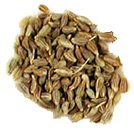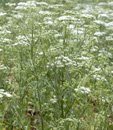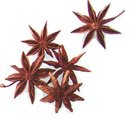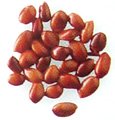Anise seed nutrition facts
Do you suffer from gripping stomach pain? Or with a cold and cough?
Take a few sips of anise seed mixed in hot water, and you instantly feel better. Nevertheless, these, tiny aromatic, spicy seeds are indeed quite prevalent in many traditional cultures for their culinary and medicinal values.
Anise botanically belongs to the Apiaceae family in the genus Pimpinella and known scientifically as Pimpinella anisum. This little-known anise plant is native to Middle-East and Mediterranean region; probably originated on the fertile plains of the Nile Delta in Egypt.

|

|
| Anise seeds. Note for brown color dry seeds with thin stalks. | Anise plant-Pimpinella anisum.Note its beautiful, white color flowers arranged in umbels. |
Anise is a perennial herbal plant that normally grows up to a height of about 2 feet. White flowers appear in the umbels by July. Harvesting is done by bringing down the whole plant once its seedheads mature enough on the plant itself. Its seeds then separated from the flower heads by threshing.
Anise seeds feature oblong or curved, comma shape, about 3-4 mm long, light brown color, and fine stripes over its outer surface.
The seeds feature a delicately sweet and aromatic bouquet with a distinctive licorice flavor. Their special fragrance is due to essential oil, anethole in them.
 |
 |
| Star anise (Illicium verum) fruits. Note for rust-red color husk. The seeds are encased inside the husk. | Star anise seeds. The seeds have a similar flavor and taste as that of anise. |
Star anise (Illicium verum) is a spicy fruit-pod, obtained from the evergreen tree native to South-West China. It has a similar flavor and taste to that of anise seed. Star-shaped fruits appear on the tree which turn rust-red color when completely ripe. On the interior, these fruits envelope small, round, amber-colored seeds. Both the seed as well as fruit husks are used as a spice in cooking.
Health benefits of Anise seeds
Exotic anise spice holds some of the important plant-derived chemical compounds that are known to have antioxidant, disease-preventing, and health-promoting properties.
The primary essential volatile oil that gives the characteristic sweet, aromatic flavor to anise seed is anethole. Other important compounds found in these grains include estragol, p-anisaldehyde, anise alcohol, acetophenone, pinene, and limonene.
Anise seed oil obtained from extraction of the seeds has been found application in many traditional medicines as a stomachic, antiseptic, anti-spasmodic, carminative, digestive, expectorant, stimulant and tonic agent.
The seeds are an excellent source of many essential B-complex vitamins such as pyridoxine, niacin, riboflavin, and thiamin. Pyridoxine (vitamin B-6) helps increase GABA neurochemical levels in the brain.
The spicy seeds are one of the important sources of minerals like calcium, iron, copper, potassium, manganese, zinc, and magnesium. 100 g dry seeds contain 36.96 mg or 462% daily required levels of iron.
Potassium is an important component of cell and body fluids that helps control heart rate and blood pressure.
Copper is a cofactor for many vital enzymes, including cytochrome C-oxidase and superoxide dismutase (other minerals function as cofactors for this enzyme are manganese and zinc). Copper is also required for the production of red blood cells.
The spice also contains good amounts of anti-oxidant vitamins such as vitamin C and vitamin A.
| Principle | Nutrient Value | Percent of RDA |
|---|---|---|
| Energy | 337 Kcal | 17% |
| Carbohydrates | 50.02 g | 38% |
| Protein | 17.60 g | 31% |
| Total Fat | 79% | 15.90 g |
| Cholesterol | 0 mg | 0% |
| Dietary Fiber | 14.6 g | 38% |
| Vitamins | ||
| Folates | 10 μg | 2.5% |
| Niacin | 3.060 mg | 19% |
| Pantothenic acid | 0.797 mg | 16% |
| Pyridoxine | 0.650 mg | 50% |
| Riboflavin | 0.290 mg | 22% |
| Thiamin | 0.340 mg | 28% |
| Vitamin A | 311 IU | 10.5% |
| Vitamin C | 21 mg | 35% |
| Electrolytes | ||
| Sodium | 16 mg | 1% |
| Potassium | 1441 mg | 31% |
| Minerals | ||
| Calcium | 646 mg | 65% |
| Copper | 0.910 mg | 101% |
| Iron | 36.96 mg | 462% |
| Magnesium | 170 mg | 42.5% |
| Manganese | 2.300 mg | 100% |
| Phosphorus | 440 mg | 63% |
| Selenium | 5.0 mg | 9% |
| Zinc | 5.30 mg | 48% |
Selection and storage
Dried as well as ground (milled) anise powder can be readily available in the spice market year-round. Choose anise seeds from organic herb stores for purity and authenticity. Buy them in small quantities so that they last for 3-4 months since they lose their flavor due to the evaporation of essential oils.
Fresh seeds should feature a bright olive-green to grey-brown color and give a rich aroma when rubbed between index and thumb fingers. Avoid seeds that have broken tips or those of old stocks as they are deprived of essential oils and, therefore, inferior in quality.
At home, store anise in airtight containers and place it in a cool, dark place. Milled (powdered) anise should be kept in airtight containers and used as early as possible since it loses its flavor rather quickly.
Star anise, in contrast, has a longer shelf life. Milled star anise should be stored in an airtight container away from sunlight.
Medicinal use
Anise seed as well as its oil found application in many traditional medicines for their unique health-promoting and disease-preventing roles.
Anise preparations are an excellent remedy for asthma, bronchitis cough as well as digestive disorders such as flatulence, bloating, colicky stomach pain, nausea, and indigestion.
The essential oil "anethole" (anise seeds comprise 75 - 90%) has been found to have an estrogenic effect. The decoction obtained from the seeds is often prescribed to nursing mothers to promote breast milk production.
Anise seed water is very helpful in relieving running nose conditions in infants.
Its seeds are chewed after the meal in India and Pakistan to refresh post-meal mouth breath. (Medical disclaimer).
Culinary uses
Anise seeds, oil as well as fresh young leaves are used in cooking. Their flavor may be heightened by gentle toasting the seeds.
Anise features a sweet, aromatic flavor. They are employed in a variety of savory and sweet dishes. The whole seeds, and often freshly milled powder, can be added to the recipes at the last moment to limit the evaporation of essential volatile oils in them.
This delicate spice is used as a flavoring base for soups, sauces, bread, cakes, biscuits, and in confectionery.
Popular aniseed flavor drinks include prenod, French pastis, Spanish ojen, etc.
Anise seeds, as well as its oil, have been in use in the preparation of sweet dishes in many Asian countries.
Its seeds are also used as a flavoring base for the preparation of herbal tea; and a liquor called anisette.
Star anise (ba jiao) is one of the most important spices in Chinese cuisine, and indeed, is the dominant flavor in Chinese five-spice powder along with cloves, cinnamon, Hua jiao (Sichuan pepper) and ground fennel seeds.
Munster-Géromé a French version of Muenster has anise seeds in the cheese.
Also read ≻≻-
≺≺ Star anise nutritonal facts and health benefits.
≺≺ Back to Spices from Anise-seed. Visit here for an impressive list of healthy spices with complete illustrations of their nutrition facts and health benefits.
≺≺ Back to Home page.
Further reading:
USDA National Nutrient Database. (opens in new window)
Gernot-Katzer's spice pages. (Opens in new window)/p>